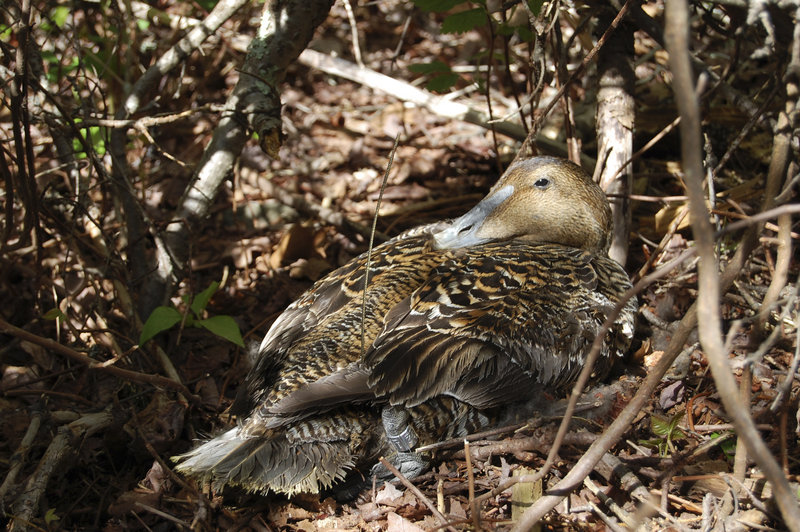Researchers have begun the first electronic tracking studies ever done in Maine to determine whether migrating birds might be disturbed by floating wind turbines off the coast.
They’ve implanted satellite transmitters inside four common eiders in Casco Bay and are keeping tabs on their movements.
The female ducks are staying close to their island nesting grounds for now. Later in the year, the transmitters hopefully will show whether they winter with groups of sea ducks farther out to sea, possibly in areas where massive wind farms are contemplated.
Migrating seabirds, raptors and songbirds can be put at risk by wind energy, if the projects are located where the birds are likely to collide with blades or towers, or if they must alter their flight paths to avoid them.
While the issue has been extensively studied on land, researchers don’t know whether conflicts exist far offshore, but they won a $20,000 grant from the Maine Outdoor Heritage Fund to try to find out.
They’ve started with eiders because nearly half the North Atlantic population breeds in Maine, according to Lucas Savoy, the waterfowl program director at the BioDiversity Research Institute in Gorham. The group studies emerging threats to wildlife and ecosystems in North and Central America.
In Europe, where near-shore wind farms are common, researchers have found that eiders avoid turbine areas.
In Maine, where energy planners envision hundreds of turbines floating at least 10 miles offshore by the end of the decade, less is known about how birds may behave. Savoy suspects they may spend winter nights in deeper water, then return to the shore during the day to feed on mussels.
As part of its research, the institute also plans to track the movements of peregrine falcons and saw-whet owls along the coast this fall.
The eider duck tracking data, represented on a Google Earth image, will be posted soon on the institute’s website: www.briloon.org
Decades of banding and surveys have given wildlife biologists a good sense of sea duck population trends in Maine, but little is known about how they move about during breeding, migration and wintering.
The state has roughly 25,000 pairs of eiders nesting off the coast, according to Brad Allen, a wildlife biologist at the Maine Department of Inland Fisheries and Wildlife, and perhaps 200,000 more that fly from Canada to spend the winter.
Allen, an eider duck expert who is helping the institute with the tracking project, said he’s skeptical that the sea ducks spend time far offshore, but his department has never had the money for satellite telemetry studies.
“I expect we’ll learn a great deal,” he said.
Maine has set an ambitious goal of developing a network of floating wind farms at least 10 miles off the coast by 2030. They would have the capacity to generate large amounts of power, and attract billions of dollars in investment and thousands of jobs.
A special task force last year designated three shallow-water demonstration sites — near Boon, Damariscove and Monhegan islands — for small-scale testing.
Allen’s department approved of the locations, and he doesn’t believe test turbines there will be a threat to eiders.
“But offshore, we know the Gulf of Maine has a lot of birds migrating over it,” he said.
If the transmitters show the four eiders spending time in deep water, the institute could use a boat or airplane to see if the ducks are gathering there in large groups, as they commonly do closer to shore.
That would be an important finding, according to Jody Jones, a wildlife ecologist at the Maine Audubon Society.
“If they can follow those four birds and it leads them to thousands of birds in rafts, that would be a tremendous contribution to our knowledge,” she said.
Maine Audubon supports “properly placed” offshore wind development, and was involved with the ocean energy task force.
Because the breezes that blow along the Maine coast support an important flyway for migrating birds, having more knowledge about bird behavior offshore will help minimize the impact of siting floating wind farms, Jones said.
“The resource the industry wants to use is the same resource the birds use,” she said.
Staff Writer Tux Turkel can be contacted at 791-6462 or
tturkel@pressherald.com
Send questions/comments to the editors.




Success. Please wait for the page to reload. If the page does not reload within 5 seconds, please refresh the page.
Enter your email and password to access comments.
Hi, to comment on stories you must . This profile is in addition to your subscription and website login.
Already have a commenting profile? .
Invalid username/password.
Please check your email to confirm and complete your registration.
Only subscribers are eligible to post comments. Please subscribe or login first for digital access. Here’s why.
Use the form below to reset your password. When you've submitted your account email, we will send an email with a reset code.